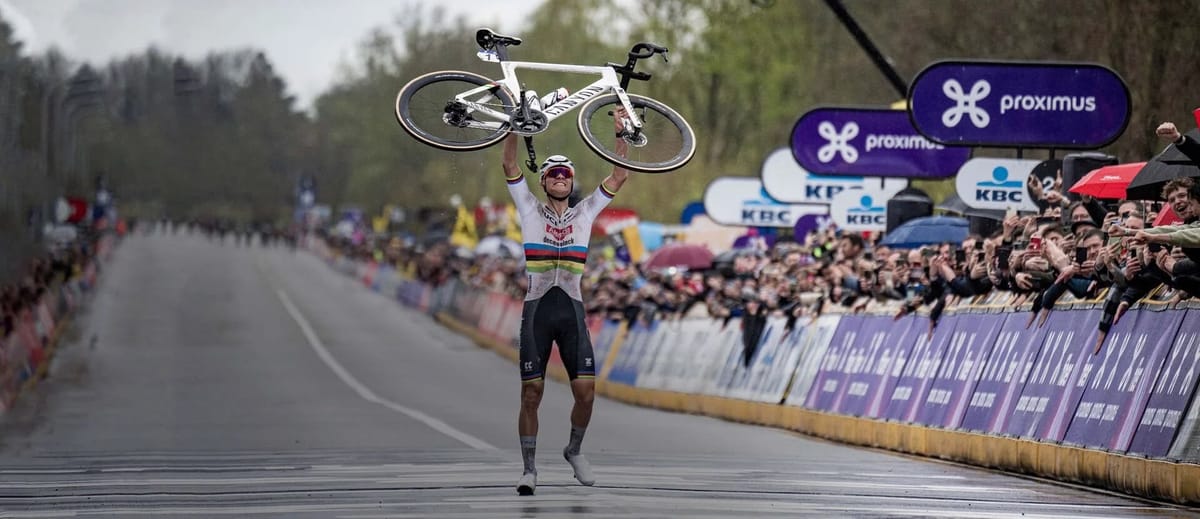Breaking Away: Why Long-Range Attacks Now Define the Spring Classics
Explore the rise of long-range solo attacks in cycling's Spring Classics. Discover how technology, nutrition, physiology, data & tactics fuel this dominant trend. (158 characters)

The hallowed cobbles and bergs of cycling's Spring Classics have always been stages for drama, attrition, and tactical chess. However, recent seasons have unveiled a striking and increasingly dominant pattern: the rise of the long-range solo attack. Where races once frequently culminated in tense, reduced bunch sprints or nail-biting finishes between small, elite groups, we now regularly witness audacious individual efforts launched from distances previously deemed impossibly far from the finish line. This isn't just a collection of fluke victories; it signals a fundamental shift in how these prestigious one-day races are being contested and won.
What forces are driving this evolution? It's a complex interplay of advanced technology, revolutionized nutritional strategies, specific physiological adaptations, data-driven tactical planning, and the inherent chaos of Classics racing. Understanding this shift requires delving into each of these crucial components.
1. The Technological Tailwind: Engineering Solo Speed
Modern racing bicycles are significantly different beasts compared to those of even a decade ago, primarily driven by a relentless pursuit of aerodynamic efficiency. This quest is reshaping how riders interact with the wind, a critical factor for anyone attempting a long solo effort.
- Frame Design Philosophy: Evolving regulations from the Union Cycliste Internationale (UCI), particularly regarding tube shape ratios (moving from 3:1 to 8:1), have allowed engineers to craft frames with more slender, elongated profiles, especially noticeable in forks and seat stays. This minimizes air resistance, enabling a solo rider to expend less energy while maintaining high speeds. Design isn't just about basic shapes; features like oversized downtubes are now meticulously sculpted to manage airflow around water bottles, and extended headtubes guide wind more effectively, leveraging rules allowing compensating triangles.
- Integration and Refinement: The gains extend beyond the main frame tubes. Internally routed cables are now standard, eliminating the drag caused by exposed wires. Integrated cockpits, combining handlebars and stems into single units, present a cleaner, more aerodynamic frontal profile. These integrated designs are the result of intensive research using Computational Fluid Dynamics (CFD) simulations and validated through rigorous wind tunnel testing, representing significant investments by manufacturers.
- Measurable Gains: The impact is quantifiable. Ridley, for instance, suggests its Noah Fast model saves around 8.5 watts at 50 km/h compared to its predecessor, citing its optimized tube shapes and integrated components. Colnago, collaborating with academic institutions, developed the Y1Rs featuring unique handlebar and seatpost designs aimed at minimizing turbulence, claiming a potential 20-watt saving at the same speed under race conditions compared to their previous V4Rs model. The Scott Foil RC Pro also highlights significant aerodynamic improvements, claiming a 16-watt saving at 40 km/h, achieved through rider-centric design and integration. These figures illustrate the tangible advantage modern bikes offer to solo attackers battling the wind.
- Rolling Resistance Revolution: It's not just about cutting through the air; it's also about interacting efficiently with the ground. The trend towards wider tires (often 28mm, 30mm, or even wider clearance as seen on bikes like the Noah Fast) might seem counterintuitive, but wider tires run at lower pressures offer lower rolling resistance on imperfect surfaces and cobbles. They deform better over bumps, reducing energy loss and increasing comfort and grip – vital for long, arduous solo missions. The Scott Foil RC, for example, pairs a 25mm front with a 28mm rear tire. Furthermore, emerging "smart" tire systems, like Scope Atmoz used in Paris-Roubaix, allow riders to adjust pressure on the fly via handlebar controls. This enables optimization for changing terrain (lower pressure for cobbles, higher for tarmac) and can help prevent race-ending punctures for a lone rider without team support immediately available.
- Head-to-Toe Aerodynamics: The focus extends to rider equipment: aerodynamic helmets, form-fitting skinsuits, and even sock height are scrutinized to shave off precious watts of drag. Every element is considered in the quest for marginal gains.
2. Fueling the Fire: The High-Carb Engine
Concurrent with technological leaps has been a revolution in endurance nutrition, particularly since around 2020. The prevailing wisdom has shifted dramatically towards maximizing carbohydrate intake during racing.
- The 120g+ Target: Where 90 grams of carbohydrates per hour was once considered the upper limit, elite endurance athletes, especially in cycling, are now pushing towards 120g/hr, with anecdotal reports suggesting some Classics riders aim for 140-160g/hr. This marks a departure from older strategies focused on metabolic efficiency and glycogen sparing.
- Optimized Absorption: This high intake is made possible by understanding how the body absorbs sugars. Using specific blends of glucose (absorbed via the SGLT1 transporter, max ~60g/hr) and fructose (absorbed via GLUT5, max ~30g/hr), often in 2:1 or 1:0.8 ratios, athletes can maximize uptake beyond what a single sugar source allows.
- Sustaining the Solo Effort: For a rider alone off the front, maintaining a relentless pace requires a constant, high supply of readily available energy. This high-carb strategy helps stave off glycogen depletion (the dreaded "bonk") far longer than previously possible, enabling sustained high power output for hours.
- Gut Training: Consuming such large quantities of carbohydrates without gastrointestinal distress requires adaptation. Riders undergo "gut training," gradually increasing their carb intake during training sessions to improve their digestive system's tolerance and absorption efficiency. This is now a critical, though often unseen, part of preparation.
3. The Anatomy of the Attacker: Physiology and Training
Not every rider is built for a 50km solo victory. Those who excel typically possess a specific physiological makeup honed by targeted training.
- The Engine and the Punch: Successful long-range attackers generally exhibit a very high aerobic capacity (VO2 max), comparable to elite climbers, allowing them to sustain high power outputs. However, they often combine this with significant anaerobic capacity, enabling the powerful initial acceleration needed to establish the break and respond to surges. They possess exceptional fatigue resistance – the ability to maintain a high percentage of their maximum power for extended durations without significant drop-off.
- The "Puncheur" Profile: This blend of endurance and power often aligns with the "puncheur" rider type, well-suited to the variable terrain of the Classics. They can attack on short, sharp climbs and sustain the effort afterwards.
- Training for the Long Haul: Training regimes reflect these demands. While sprinters focus on peak power and climbers on sustained power-to-weight, the long-range attacker's training includes substantial endurance work, threshold training (improving sustained power), high-intensity intervals (boosting anaerobic capacity and recovery), and specific sessions simulating attacking and then settling into a hard, sustainable pace. Mental resilience training is also crucial for enduring the isolation and pressure of a solo break.
4. Data-Driven Gambit: Analytics in Attack and Defence
Modern cycling is awash with data, and teams leverage it strategically to inform race-defining decisions.
- Powering Decisions: Power meters provide granular data on rider output. Analyzing this helps identify riders with the physiological capacity for long solos, tailor training, and gauge fatigue levels during a race. Real-time power data can signal the opportune moment for a rider to launch an attack when they are in a peak performance window.
- Real-Time Tactics: GPS tracking gives team directors immediate insights into rider locations and time gaps. This allows for calculated decisions on whether to chase, bridge, or launch counter-attacks, assessing the viability of bringing back a solo rider based on distance, terrain, and perceived effort levels.
- Predictive Power: Increasingly sophisticated race simulations model scenarios based on course profiles, weather, and rider capabilities. This helps teams identify strategic points for attacks or anticipate vulnerabilities in the peloton, moving tactics from reactive to proactive.
5. Tactical Context: When and Why They Go
These attacks don't happen in a vacuum. The tactical situation and peloton dynamics are critical.
- Timing and Terrain: Long-range attacks often launch after particularly demanding sectors (key climbs, cobbled stretches) have softened up the peloton, making organized chases harder. Crosswind sections can also provide opportunities, as drafting benefits are reduced.
- Peloton Paralysis: Hesitation or disorganization in the chasing pack is often the breakaway's greatest ally. If no single team takes immediate responsibility, or if key rivals mark each other out of the chase, a solo rider can quickly gain a decisive advantage. Underestimating the attacker's strength or resolve is a common pitfall for the bunch.
- Illustrative Examples: Recent Classics history is rich with examples – Kasper Asgreen's resilient double-attack at E3 2021, Dylan van Baarle's powerful solo at Omloop 2023, Tadej Pogačar's dominant move at Liège-Bastogne-Liège 2022, and Mads Pedersen's long-range win at Gent-Wevelgem 2022 all underscore this trend.
6. Countering the Lone Wolf
While successful, long-range attacks aren't invincible. Effective counter-strategies exist:
- Organized Chase: The most direct counter is a committed, coordinated chase involving multiple teams sharing the workload.
- Team Tactics: Strong teams can launch counter-attacks to disrupt the chase rhythm or bridge to the leader, putting pressure on the solo rider.
- Anticipation: Identifying likely attackers and reacting swiftly to close down moves before they gain significant time is crucial. Good positioning near the front is key.
Looking Ahead: An Evolving Battlefield
The trend of long-range solo attacks seems set to continue, driven by ongoing technological refinement, deeper nutritional understanding, and increasingly sophisticated data analysis. Future UCI rule changes or course alterations could influence tactics, but the versatile, powerful rider capable of sustained solo efforts currently holds a potent weapon. We can expect teams to develop even more refined strategies for both launching and neutralizing these attacks, ensuring the tactical evolution of the Spring Classics continues.
Conclusion: The Enduring Allure of Audacity
The rise of the long-range solo attack in the Spring Classics is a multifaceted phenomenon, born from the convergence of cutting-edge technology, optimized fueling, specific physiological prowess, and data-informed strategy. While fans may debate whether this enhances or diminishes the spectacle compared to traditional finales, the sheer audacity and physical dominance required for a successful long solo effort remain undeniably captivating. It represents individual brilliance against the collective might of the peloton, a testament to courage and endurance that adds a thrilling, often unpredictable dimension to cycling's most revered one-day races. This tactical evolution ensures the Spring Classics will continue to be a dynamic and compelling theatre of endurance sport.





